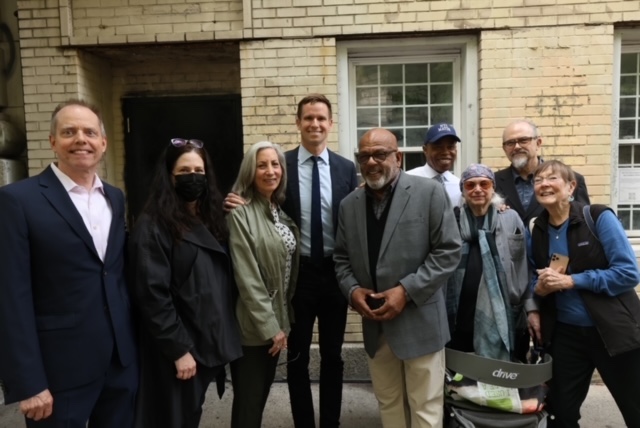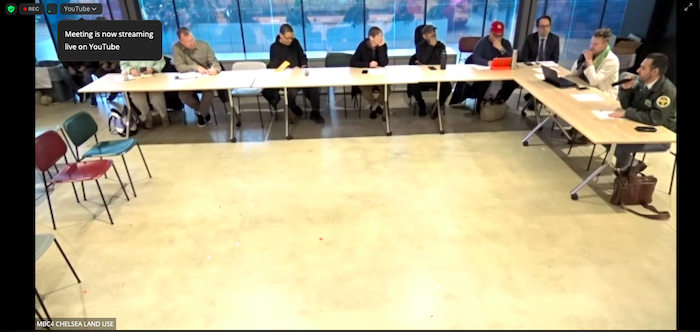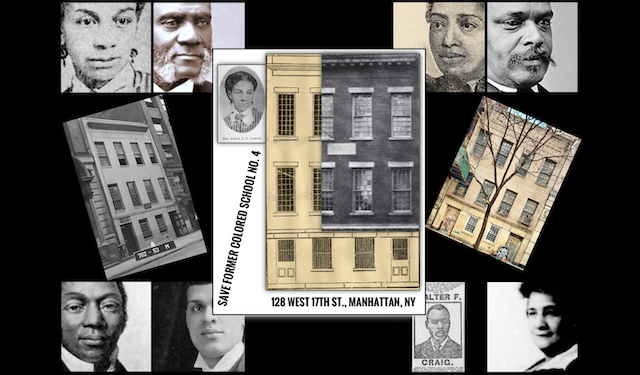
BY SCOTT STIFFLER | The half-decade-long quest to landmark 128 West 17th Street—Manhattan’s only surviving example of a segregated NYC public school for African Americans—met with success last year. Now, the driving forces behind that accomplishment are hoping the building’s historically significant interior elements will survive by the time construction, currently underway, is completed.
That could be as far away as 2029, according to the NYC Department of Sanitation (DSNY), current owners of the structure. Also known as “Former Colored School No. 4” (referencing its 1864-1894 function), the building was utilized as “a section house for the Department of Sanitation” from 1936 to 2015, noted DSNY Superintendent Stephen Caruso during his March 18 presentation to Manhattan Community Board 4 (MCB4) via their Chelsea Land Use (CLU) committee. (Click here to view the meeting.)
“We use them almost as sub-garages in the sense that workers would go there to clean up or take their breaks or meet their supervisor,” explained Caruso. Although such facilities still exist, “They don’t have the same significance as they once did.” Wear and tear over the decades, he said, means, “This particular piece of property is in need of some rehab.” And until that’s completed, he noted, DSNY has no plans to make plans about relinquishing its ownership of the building or identifying its future role. “So as of right now,” said Superintendent Caruso, “we are in the construction planning and design process… By 2029 if not sooner we will have a fully usable blank canvas—and by ‘blank canvas,’ I mean a safe, clean, and usable space.”
DSNY’s decision to retain ownership of the building cements its status as steward of the overhaul effort currently underway, paid for with $6 million in reparative funding announced by NYC Mayor Eric Adams on May 23, 2023. “Water infiltration and general age-related deterioration” were concerns, according to the press release, which also noted, “Engineering investigation and design work” had already begun. (Click here to access the press release.)
Mayor Adams’ funding announcement came on the same day the NYC Landmarks Preservation Commission (LPC) voted unanimously to designate the three-story brick structure as an individual landmark. That move preserves its exterior integrity, but there’s no similar mandate for what’s inside—hence the concern from advocates who helped achieve the landmarking. Several of them met on May 6 as an informal, invite-only first step toward forming a new coalition focused on contemporary concerns.
Among those involved in forming that effort—(working name, Coalition for the Future of Former Colored School No. 4 (CFFCS4)—is historian Eric K. Washington, who first brought 128 West 17th Street to public attention while conducting research for his acclaimed 2019 biography Boss of the Grips: The Life of James H. Williams and the Red Caps of Grand Central Terminal. (Williams was among the school’s African Americans students, four to 14 years of age.)
“Its graduates and teachers were the progenitors of myriad citizen leaders who would effectively build the community of Harlem, even farther Uptown, into the renowned 20th-century capital of Black America,” noted Washington, whose interest in the school didn’t stop at collecting a great backstory for his biography project. In 2018, having amassed much information about the building’s storied past, Washington filed paperwork with the LPC that essentially jump-started the landmarking process.
Over the next several years—as the landmarking effort picked up support from preservationist groups, architects, and everyday New Yorkers—Washington’s research revealed dozens of other facts about the school. So broad and persuasive was his work that MCB4, local NYC Council Member Erik Bottcher, and even LPC members began referring to him as a consulting authority—indeed, the leading historian—on 128 West 17th Street’s stint as a segregated NYC public school.

Washington, still conducting research in support of a book proposal about the school (and his desire to see it added to the National Register of Historic Places), notes new facts have emerged “even since [the CLU meeting of] March 18. Just in the past few weeks, I’ve come up with a lot more information about figures who were associated with the school and the politics of it being a separate, colored school when there was talk about whether to keep it open or close it.”
These days, talk has centered around the building’s long-term ownership and use—with MCB4 and Washington wondering why DSNY’s construction timetable is as far as five years from its end point, and frustrated at the all-stop that’s been put on future ownership and usage. It’s a far cry from just over a year ago, when the landmarking vote of May 23, 2023 produced a moment in time that saw nearly all participants standing in solidarity. Indeed, the mayoral press release went so far as to predict, “DSNY will work with city agencies and local stakeholders to identify an appropriate long-term use for the facility” albeit only “following the renovation.”
Post-landmarking scenarios have been on the mind of MCB4 for years, as demonstrated in its November 10, 2021 letter to the LPC noting, “Colored School No. 4 could be an excellent learning environment for New York City’s children and families to understand the heritage and migratory path of black residents over the centuries.” It could also, the letter suggested, “illustrate the segregated policies in the city’s educational system in the 1800’s while providing examples of African Americans who made important contributions to the society.”
Flash forward to the CLU’s recent March 18 meeting, and 128 West 17th Street’s life beyond landmarking remained a topic of curiosity, as was protecting the building’s interior integrity during construction. DSNY Superintendent Caruso repeatedly declined to engage on those matters, but noted more than once that he’d share such concerns. “Okay the message is well received,” he said at one point (the 13-minute, 18-second point, to be precise), adding, “I will absolutely make sure to bring that back [to DSNY leadership].”

Washington expressed concern over DSNY’s shelving of plans for the building’s ownership and long-term purpose until their construction work is done. “A lot of things can happen in five years that might be averse to the advancement of the site,” he said, referencing new names in local leadership positions who may not be aligned with the concerns that inspired May 6’s Zoom-held gathering, anticipating the new coalition being put together by Washington, architect K. Kennedy Whiters (founder of Black in Historic Preservation), and architect and preservationist Angel Ayón.
In addition to that trio, in attendance on May 6 were members of the New York Landmarks Conservancy, the Municipal Arts Society of New York, and the Historic Districts Council as well as Roberta Washington (an architect with experience in preservation), NYU Professor of Social & Cultural Analysis Kimberly Johnson, and MCB4’s Jesse Bodine (District Manager) and Kerry Keenan (CLU Co-Chair),
Washington said that as the coalition, well, coalesces, CFFCS4 hopes to work with other groups and individuals whose advocacy during the landmarking process was instrumental to its success. As for this new effort, “One of the goals is to put some sort of [collective] voice to DSNY and the city that says, ‘We think your approach to the building should be through the lens of preservation,’ ” said Washington, adding, “At this stage, we think there should be a preservation assessment. A prequalified professional practitioner can help to clarify what the existing conditions are; what warrants immediate protection on-site, or removal—and we’d like to see the City follow preservation best practices as recommended by the National Park Service.”
In a May 1 email to Chelsea Community News (CCNews), Vincent Gragnani, DSNY’s Press Secretary, Bureau of Public Affairs, said the design and renovation work “is ongoing and will take several years. Discussions about the future of the building are premature and, ultimately, will not be the sole decision of the Department of Sanitation.” Gragnani also seemingly shut the door on requests by Washington and others to tour the building again. “At this point,” noted Gragnani’s email, “it would not be safe to bring people into the building.”

That seemingly puts the kibosh on some content from an MCB4 letter sent to DSNY on May 3, requesting an answer to the question, “Is DSNY still amenable to relinquishing the building to another agency/entity, as Gregory Anderson suggested at Councilman Bottcher’s May 23, 2022, Zoom meeting?” Among the letter’s other inquiries: Whether the building’s roof has been “fully repaired and/or sealed to prevent further water damage.” This concern traces back to December 15, 2022 when MCB4 members, Council Member Bottcher, and Washington were allowed by DSNY to tour Former Colored School No. 4 in order to assess its condition. (To read Chelsea Community News’ report on that tour, click here). In an email sent to CCNews shortly after the visit, CLU Co-Chair Kerry Keenan noted they observed “significant water damage caused by a failure to mitigate the roof leak.” The concern was brought up at March 18’s CLU meeting, when public member Pamela Wolff included it in a list of reasons CB4 wanted a return visit to the site.
In a May 7 email to CCNews, Council Member Bottcher–who was instrumental in securing the 2022 on-site visit and has been in touch with DSNY regarding a return, called the historic preservation of Former Colored School N0. 4 “a top priority for our community,” vowing his Office is “committed to working with preservationists, Community Board 4, DSNY, and residents of Chelsea to ensure the historic fabric of the building is preserved, as we discuss its future use as a cherished resource for the people of New York City.”
MCB4, for its part, is taking the old “trust but verify” approach to relations with DSNY. Their May 3 letter contained a request to provide the community with “construction updates as to the progress of the project,” and—reflecting concerns voiced by multiple CLU members as well as Washington during the March 18 meeting—asked, “Will DSNY work with community stakeholders to tour the interior of the building and conduct an audit of the historic built interior?” Among the concerns MCB4 specified were historic plumbing fixtures, street-facing windows, and “the remains of the narrow-plank floor” on the second floor, which “has been damaged beyond repair by the roof leaks.”
Although MCB4 has yet to receive responses specific to the content of its May 3 letter, Joshua Goodman—DSNY Deputy Commissioner, Public Affairs & Customer Experience—did supply some reassurance in a May 6 email to Chelsea Community News. “This project is still in the design phase,” he said, also noting the LPC “is involved in the process, given that they have granted the building landmark protections. DSNY files reports with the LPC about planned work.”
—END—
For More on This Topic, See the Below Links to Previous Coverage by CCNews
Chelsea Community News is an independent, hyperlocal news, arts, events, info, and opinion website made possible with the help of our awesome advertisers and the support of our readers. Our Promise: Never a paywall, no pop-up ads, all content is FREE. With that in mind, if circumstances allow, please consider taking part in our GoFundMe campaign (click here). To make a direct donation, give feedback, or send a Letter to the Editor, send an email to Scott Stiffler, via scott@chelseacommunitynews.com.
To join our subscriber list, click here. It’s a free service providing regular (weekly, at least) Enewsletters containing links to recently published content. Subscribers also will be sent email with “Sponsored Content” in the subject line. That means it’s an exclusive message from one of our advertisers, whose support, like yours, allows us to offer all content free of charge.

Pingback: The January Committee Meetings of Manhattan Community Board 4 (MCB4) - Chelsea Community News